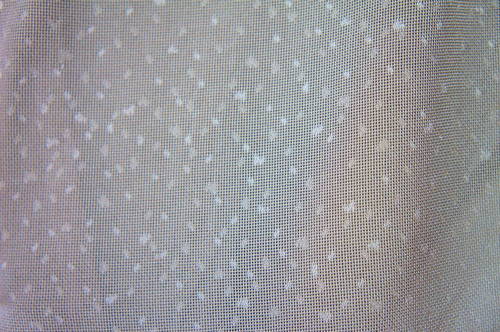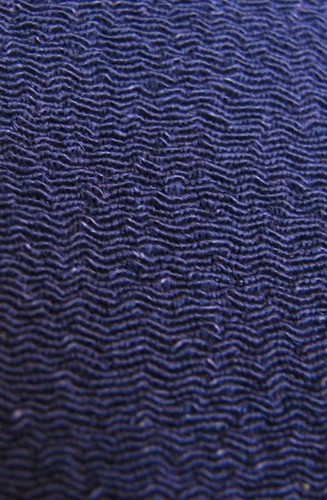Kimono patterns can be divided into two, the woven patterns and the dyed patterns. In terms of formality, the dyed patterns are more formal than the woven ones. Let's start with the woven patterns.
Woven patterns are symmetric and often also geometric, such as the stripes, checks and the splash pattern known as kasuri.
Kasuri is a tie-dye technique that originated in India. It is an ikat technique in which the warp threads can been dyed or solid color and the weft threads are tie-dyed in specific pattern and dyed with indigo to create a pattern once the fabric has been woven. Basic kasuri patterns are cross and parallel cross designs. The more complex are the pictorial kasuri, where pines, bamboo, plum blossoms, cranes, tortoises and so on are woven into the design.
 |
| Kasuri fabric by hillesondesigns.com |
Reeled silk known as meisen. Meisen has that "wind swept" look in the pattern. Meisen was first produced in the later part of the meiji period (1868-1910) through to around 1955. It's hight was in the Taisho period (1910-1926) throught to the early 1940's. They were inexpensive and first "off-the-rack" ready to wear kimono and haori. Meisen is a technique for producing kasuri (ikat) fabric cheaper, faster and in larger quantities than the traditional method allowed.
For more information and beautiful pictures, please see the Meisen Kimonos Exhibition.
 |
| Meisen silk by marcusonandhall.com |
Heavy crepe silk known as omeshi. Kimono.fraise.net calls this weave the "fuzzy weave" and I have to agree on it, it does look fuzzy. Omeshi, also, is created with kasuri technique. Omeshi is a heavy crepe silk fabric with strongly twisted threads and firmer in it's texture than chirimen. Traditionally omeshi ranks highest of the woven fabrics in formality.
 |
| Omeshi silk by kimono.fraise.net |
Spun silk known as tsumugi. Tsumugi originates from the farmers who wished to make use of the cocoons left over after they had shipped the best ones into the markets. They collected the floss from the left over cocoons and spin (tsumugu) it into kimonos for themselves and their families. Tsumugi as a fabric is one of the oldest, still used weaving techniques. It has a soft, but uneven texture and superficially resembles cotton.
 |
| Tsumugi silk bolt by petitjapon.com |
Silk gauze known as sha. The loose weave of this fabric makes it a see-through material.
 |
| Sha kimono by KyotoAntique. |
Leno weave gauze known as ro. Just as sha, ro is very light fabric an distinguishable by the horizontal "stripes" that the weave creates on the surface of the fabric.
| Ro kimono bolt by KyotoAntique. |
Stripe pattern is called shima.
| Shima yukata by shop-kimono.com |
The check or lattice pattern called koushi.
 |
| Koshi kimono by narablog.com |
Linen is known as the joufu in terms of patterns, which corrects my statement that I was not sure if I have ever seen a linen kimono. Now I have.
 |
| Linen joufu patterned kimono by narablog.com |
Crepe silks known as the chirimen and kinsha. They have textured surface, similar to crepe, which is achieved by twisting the threads during weaving. Chirimen is heavier and stronger than kinsha. It's also a plain weave silks and drapes exceptionally well. Kinsha is a fine weaved, light crepe like silk.
 |
| Chirimen silk by nifwlseirff in Flickr. |
 |
| Kinsha silk by nifwlseirff.hubpages.com |
Rinzu silk is brocade like fabric with intricate pattern. Creating this pattern requires great skill and expertise and these silks are, as you might have guessed, one of the most expensive silks in Japan. The use of different types of warp and weft threads creates a contrast in the foreground and background adding luster and texture to the fabric. Rinzu fabrics can also have a dyed pattern on top of the woven pattern. These fabrics are soft to the touch and can vary in weight from the very light into the heavy wedding kimono.
 |
| Rinzu silk by Rakuten. |
Urushi silks are created by weaving lacquered threads into the pattern creating an embroidery like pattern.
 |
| Urushi by Ruby Kimono. |
Reference used:
Kasuri Home - glossary
The Book of Kimono by Norio Yamanaka
And again, if you notice some obvious mistakes, please contact me. I am not perfect ;).
Ei kommentteja:
Lähetä kommentti